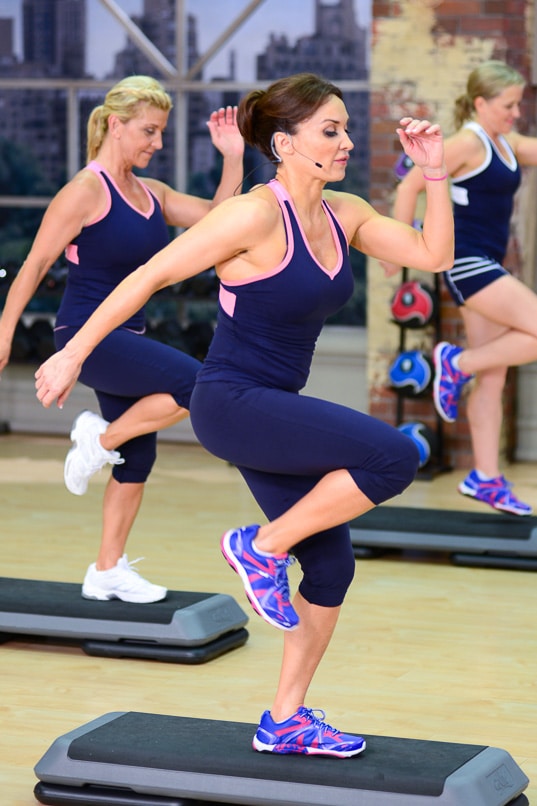 One thing that all women need to be concerned about is maintaining bone density. By the ripe, young age of 50, one out of five women already has osteoporosis, although they may not realize it until they experience an unexpected fracture. Some people are at higher risk than others – those with small bones, a low BMI, family history, being Caucasian or Asian and those who smoke. Regular exercise is one of the best ways to prevent loss of bone density.
One thing that all women need to be concerned about is maintaining bone density. By the ripe, young age of 50, one out of five women already has osteoporosis, although they may not realize it until they experience an unexpected fracture. Some people are at higher risk than others – those with small bones, a low BMI, family history, being Caucasian or Asian and those who smoke. Regular exercise is one of the best ways to prevent loss of bone density.
The general consensus is that aerobic exercise needs to be high impact to spur bone growth. For example, a meta-analysis published in the journal Bone showed that walking was insufficient for preserving spinal density in post-menopausal women although it did help to maintain bone density in the neck of the femoral bone. What about step training? Does it offer enough of a stimulus to improve bone density?
Step Training Workouts and Bone Density
A study carried out at Health Promotion Research in Finland looked at the impact of step training on bone density. A group of 79 young women was divided into three groups. One group did a lower-body strength training routine for six months while the other did high-impact step aerobics. A third group did no formal exercise.
As expected the two groups that worked out showed the greatest improvement in bone density, but the group that did high-impact aerobics fared best. They experienced significant improvements in leg, lumbar spine and hip bone density including a 3.3% increase in hip bone density, a 1.2% improvement in lumbar spine density and an increase in leg bone density of 0.9%. The strength-training group showed modest increases in hip bone and heel bone density but leg bone density dropped slightly. Not surprisingly, participants who did lower-body strength training had measurable increases in leg strength.
It appears that a high-impact step training workout offers significant advantages when it comes to preserving bone density. Other research suggests that step aerobics may be more effective for boosting bone density than jogging or running. One reason may be stepping involves multiple changes in direction, which stimulates greater bone growth than movements in a single direction.
A Combination of Step Aerobics and Resistance Training is Ideal
In this study, high-impact step aerobics outperformed resistance training, but other research shows that resistance training using resistance bands or weights can boost bone growth by as much as 1% over a twelve month period, especially in the spine and hip area. A combination of resistance training and high-impact aerobics offers multiple benefits: greater bone density, cardiovascular benefits, and strong muscles. Plus, resistance training helps to prevent loss of lean body mass with age.
To get the bone-preserving benefits of high-impact exercise you don’t have to do a high-impact workout every day. Research shows that even limited amounts of this type of exercise, once or twice a week, have bone density benefits.
Of course, step training isn’t the only way to boost bone growth, any form of high-impact exercise where both feet leave the ground maximally stimulates bone growth. On the other hand, low-impact exercise or exercises like swimming where there’s no load on the bones aren’t effective for maintaining or improving bone density.
Nutrition is Important for Bone Health Too
Although high-impact exercise and resistance training are effective for improving bone mass, you may not get the full benefit unless you’re getting enough calcium in your diet and have adequate levels of vitamin D. A few studies have failed to show the benefits of exercise for preserving bone mass, although the overwhelming majority have. Experts believe studies that failed to show a link may have been due to insufficient dietary calcium or vitamin D. So it’s important to combine high-impact exercise, like step aerobics and resistance training, with a diet that’s rich in calcium and vitamin D.
Two other minerals, magnesium and potassium are also important for bone health, and there’s growing evidence that vitamin K plays a role in maintaining bone density. Make sure you’re getting enough of these vitamins and minerals by eating a diet of vitamin and mineral-rich whole foods.
The Bottom Line?
When you’re doing a step training workout, you’re not only burning calories, you’re helping to maintain your bone density – so get out the step and your Cathe step DVDs!
References:
Bone. 2008 Sep;43(3):521-31.
Int J Sports Med. 2011 Feb;32(2):100-8.
Medscape Family Medicine. “Exercise Program Improves Osteoporosis”
Sports Med. 2009;39(6):439-68.
Harvard School of Public Health. “Vitamin K”
Osteoporos Int. 2009 Feb;20(2):335-40.
Related Articles By Cathe:
Why You Should Add Step Training to Your Routine and Tips for Getting the Most Out of Stepping

